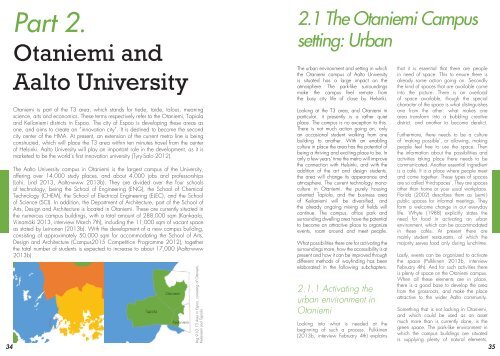View/Open - Aaltodoc
View/Open - Aaltodoc
View/Open - Aaltodoc
You also want an ePaper? Increase the reach of your titles
YUMPU automatically turns print PDFs into web optimized ePapers that Google loves.
Part 2.<br />
Otaniemi and<br />
2.1 The Otaniemi Campus<br />
setting: Urban<br />
34<br />
Aalto University<br />
Otaniemi is part of the T3 area, which stands for tiede, taide, talous, meaning<br />
science, arts and economics. These terms respectively refer to the Otaniemi, Tapiola<br />
and Keilaniemi districts in Espoo. The city of Espoo is developing these areas as<br />
one, and aims to create an “innovation city”. It is destined to become the second<br />
city center of the HMA. At present, an extension of the current metro line is being<br />
constructed, which will place the T3 area within ten minutes travel from the center<br />
of Helsinki. Aalto University will play an important role in the development, as it is<br />
marketed to be the world’s first innovation university (Tyry-Salo 2012).<br />
The Aalto University campus in Otaniemi is the largest campus of the University,<br />
offering over 14,000 study places, and about 4,000 jobs and professorships<br />
(Lohi, Lind 2013, Aalto-www 2013b). They are divided over the four schools<br />
of technology, being the School of Engineering (ENG), the School of Chemical<br />
Technology (CHEM), the School of Electrical Engineering (ELEC), and the School<br />
of Science (SCI). In addition, the Department of Architecture, part of the School of<br />
Arts, Design and Architecture is located in Otaniemi. These are currently situated in<br />
the numerous campus buildings, with a total amount of 288,000 sqm (Kankaala,<br />
Viinamäki 2013, interview March 7th), including the 11,000 sqm of vacant space<br />
as stated by Leinonen (2013b). With the development of a new campus building,<br />
consisting of approximately 50.000 sqm for accommodating the School of Arts,<br />
Design and Architecture (Campus2015 Competition Programme 2012), together<br />
the total number of students is expected to increase to about 17,000 (Aalto-www<br />
2013b).<br />
Img 9-10: T3 Area in Espoo, consisting of Otaniemi,<br />
Keilaniemi and Tapiola<br />
The urban environment and setting in which<br />
the Otaniemi campus of Aalto University<br />
is situated has a large impact on the<br />
atmosphere. The park-like surroundings<br />
make the campus feel remote from<br />
the busy city life of close by Helsinki.<br />
Looking at the T3 area, and Otaniemi in<br />
particular, it presently is a rather quiet<br />
place. The campus is no exception to this.<br />
There is not much action going on, only<br />
an occasional student walking from one<br />
building to another. With an enabling<br />
culture in place the area has the potential of<br />
being a thriving and exciting place to be. In<br />
only a few years’ time the metro will improve<br />
the connection with Helsinki, and with the<br />
addition of the art and design students,<br />
the area will change its appearance and<br />
atmosphere. The current technology monoculture<br />
in Otaniemi, the purely housing<br />
oriented Tapiola, and the business area<br />
of Keilaniemi will be diversified, and<br />
the already ongoing mixing of fields will<br />
continue. The campus, office park and<br />
surrounding dwelling area have the potential<br />
to become an attractive place to organize<br />
events, roam around and meet people.<br />
What possibilities there are for activating the<br />
surroundings more, how the accessibility is at<br />
present and how it can be improved through<br />
different methods of wayfinding has been<br />
elaborated in the following subchapters.<br />
2.1.1 Activating the<br />
urban environment in<br />
Otaniemi<br />
Looking into what is needed at the<br />
beginning of such a process, Pulkkinen<br />
(2013b, interview February 4th) explains<br />
that it is essential that there are people<br />
in need of space. This to ensure there is<br />
already some action going on. Secondly<br />
the kind of spaces that are available come<br />
into the picture. There is an overload<br />
of space available, though the special<br />
character of the space is what distinguishes<br />
one from the other: what makes one<br />
area transform into a bubbling creative<br />
district, and another to become derelict.<br />
Furthermore, there needs to be a culture<br />
of ‘making possible’, or allowing, making<br />
people feel free to use the space. Then<br />
the information about the possibilities and<br />
activities taking place there needs to be<br />
communicated. Another essential ingredient<br />
is a café. It is a place where people meet<br />
and come together. These types of spaces<br />
are so called ‘third-spaces’. They are spaces<br />
other than home or your usual workplace.<br />
Florida (2002) describes them as (semi-)<br />
public spaces for informal meetings. They<br />
form a welcome change in our everyday<br />
life. Whyte (1988) explicitly states the<br />
need for food in activating an urban<br />
environment, which can be accommodated<br />
in these cafés. At present there are<br />
mainly student restaurants, of which the<br />
majority serves food only during lunchtime.<br />
Lastly, events can be organized to activate<br />
the space (Pulkkinen 2013b, interview<br />
February 4th). And for such activities there<br />
is plenty of space on the Otaniemi campus.<br />
When all these elements are in place,<br />
there is a good base to develop the area<br />
from the grassroots, and make the place<br />
attractive to the wider Aalto community.<br />
Something that is not lacking in Otaniemi,<br />
and which could be used as an asset<br />
much more than is currently done, is the<br />
green space. The park-like environment in<br />
which the campus buildings are situated<br />
is supplying plenty of natural elements.<br />
35
















